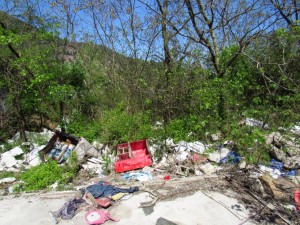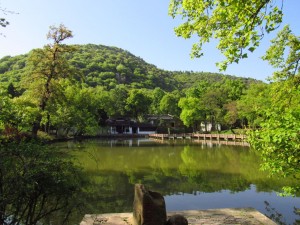
Spring butterflies in the bamboo Ever since my profound experience of searching for the Satyrid butterfly Drucina championi in Guatemala in 2011, which is entirely dependent on bamboo, I have felt a special affinity with the butterflies of this habitat. Last weekend I joined a group of hikers who go out of Suzhou every weekend to hike in forested areas away from the city. Their destination this time was an area of forested hills far to the west of Suzhou, on the other side of the huge Taihu Lake, an area of that specializes in the production of bamboo shoots for consumption in restaurants. When we emerged from the bus after the nearly 2-hour journey, I spotted numerous racks of whitish somethings drying in the sun.
 At first I was not sure what these white things drying in the sun were
At first I was not sure what these white things drying in the sun were
At first I thought they might be some kind of fish, or even animal bones of some sort, but eventually it became clear that they were in fact pieces of bamboo shoot, cut up and laid out to become desiccated. When they are finally cooked, they need to be rehydrated, and then they return to their original shape and consistency.
 I thought they might be fish or some kind of animal bones, but they were cut up bamboo shoots
I thought they might be fish or some kind of animal bones, but they were cut up bamboo shoots
The whole village apparently survives from this industry, and as we walked up the long street, on either side there were more and more racks, almost all of this bamboo, but with the occasional basket of tea leaves as well. The hills above were covered with bamboo groves, and once we reached the car park at the road end, we climbed steeply up into these forests, stopping to catch our breath and to have a snack about halfway up. Eventually we reached a viewpoint on the ridge, and were treated to a fine view of the forested hills beyond.
 The group setting off into the bamboo forest
The group setting off into the bamboo forest
 The hills beyond were covered with beautiful forest
The hills beyond were covered with beautiful forest
From here our route took us downhill, again through further groves of bamboo, and eventually we stopped by a riverbed, where our guide got out a camping gas stove and started to heat up some soup with sticky rice sticks in it, a welcome repast after the rigours of the morning’s hike.
 Myself on the border between Jiangsu and Zhejiang Provinces
Myself on the border between Jiangsu and Zhejiang Provinces
I took advantage of the break to check out some Spring butterflies that were flying around, and managed to photograph the beautiful Chinese Orange-tip, Anthocharis bambusarum (which despite its specific name, is not especially associated with bamboo) and a Short-tailed Blue, Everes argiades.
 Unlike our familiar Orange-tip, Anthocharis bambusarum has the entire forewing orange
Unlike our familiar Orange-tip, Anthocharis bambusarum has the entire forewing orange
 The Short-tailed Blue, Everes argiades, was a pleasant sight in the Spring sunshine
The Short-tailed Blue, Everes argiades, was a pleasant sight in the Spring sunshine
After lunch, we continued on our way, passing through a village that was full of quite attractive new hotels, and eventually we reached a dam, where various group photos were taken.
 The lake we passed on our hike
The lake we passed on our hike
If we had thought that the morning walk was strenuous, what then followed made it seem like a walk in the park. Our guide led us up into the forest, and we climbed ever higher up an almost vertical slope, heaving ourselves up on trees and bamboo stems. After a long time, our guide suddenly informed us that he was lost, and that we would have to go all the way back down again. Some members of the group were inexperienced walkers, and were clearly suffering somewhat. Still, it had to be done, and eventually we found the correct path, which then led us up again through some tea plantations and into the forest, which was adorned with colourful flowering Azaleas (as well as numerous discarded plastic bottles - littering is as much of a problem here as anywhere else).
 The group toiling up through the tea plantations
The group toiling up through the tea plantations
 Plastic litter is as much of a problem here as elsewhere
Plastic litter is as much of a problem here as elsewhere
We finally reached the bus two hours after scheduled, and then found that the highway back to Suzhou was blocked, and it was not until 22.30 that we were finally dropped off … and no taxi was available. I had visions of a very long walk home indeed, but eventually, after at least 40 minutes of waiting, I managed to find one and arrived home exhausted! The following day, Sunday, I set off on my own by subway to Mudu station, in the west of Suzhou, and then walked to one of my old haunts from last Autumn, Linyang Mountain. Here I almost immediately got into butterfly mode, starting off with several beautiful examples of another species of Orange-tip, Anthocharis scolymus.
 The hooked wingtip of Anthocharis scolymus is very distinctive
The hooked wingtip of Anthocharis scolymus is very distinctive
I was familiar with this dainty butterfly from my time in Japan, and I was able to get very close to several individuals as they were nectaring and egg-laying on the cruciferous plants by the path.
 I was delighted to reacquaint myself with Anthocharis scolymus
I was delighted to reacquaint myself with Anthocharis scolymus
I also spotted my first Indian Fritillary, Argyreus hyperbius, of the year, as well as several newly-emerged Small Coppers, Lycaena phleas. Several Eastern Pale Clouded Yellows, Colias erate, were flying around here too, but none sat for long enough for me to photograph them.
 The Small Copper, Lycaena phleas, is always a delight to see
The Small Copper, Lycaena phleas, is always a delight to see
 The first Indian Fritillary, Argyreus hyperbius, of the year
The first Indian Fritillary, Argyreus hyperbius, of the year
From here I skirted the edge of the forested hill, and reached a Buddhist temple, from where I headed a short way along a track into the forest. Along here I was treated to some fine viewings of the beautiful Common Bluebottle, Graphium sarpedon, and a Blue Admiral, Kaniska canace, as well as a few Common Grass Yellows, Eurema hecabe. The trash dumped here had to be seen to be believed, which I found distressing.
 The Common Bluebottle, Graphium sarpedon, is normally hard to photograph
The Common Bluebottle, Graphium sarpedon, is normally hard to photograph
 A Common Grass Yellow, Eurema hecabe, camouflaged among the leaves
A Common Grass Yellow, Eurema hecabe, camouflaged among the leaves
 A beautifully located building on the way to Tianping Mountain
A beautifully located building on the way to Tianping Mountain
 The temple here is beautifully situated
The temple here is beautifully situated
 Dumping of rubbish is a major issue here
Dumping of rubbish is a major issue here
I then continued along the roadway, and eventually arrived at the entrance gate of Tianping Mountain, where an entrance fee had to be paid. It was well worth the money though, as it turned out to be easily the most attractive spot I have found in Suzhou so far, and the trees were looking pristine in their new Spring foliage.
 The gate to Tianping Park is attractive in itself
The gate to Tianping Park is attractive in itself
 Tianping Mountain with Spring foliage
Tianping Mountain with Spring foliage
 Another pond near Tianping Mountain
Another pond near Tianping Mountain
After an initial look around the ponds and pavilions close to the entrance, I started to climb, without really intending to aim for the top of the mountain. However, I wandered on upwards, and eventually reached the ridge, from where I could see the temple that sits just below the summit.


As well as being an attractive spot in itself, the views from here over the sprawling urban mass of Suzhou were impressive to see, and I lingered a while here, taking in the vistas in different directions.
 Suzhou sprawls away into the distance below Tianping Mountain
Suzhou sprawls away into the distance below Tianping Mountain
 Another part of Suzhou seen from Tianping Mountain
Another part of Suzhou seen from Tianping Mountain
I finally made a push for the top, which I reached after a sharp pull up a well-trodden track. Quite a number of people had made the climb, and even a couple of ladies selling drinks were there in their kiosk. What interested me was a Japanese Swallowtail, Papilio xuthus, that was indulging in “hill-topping”, a habit of several butterflies, particularly members of the swallowtail family. The butterfly was patrolling its territory at considerable speed, and did not sit down to be photographed at all. Also here was another attractive, but much smaller, butterfly, Rapala micans, a member of the hairstreak group.
 Rapala micans on Tianping Mountain
Rapala micans on Tianping Mountain
I then began my descent, pausing on the way to photograph anything interesting that I could find, including a cooperative Common Sailer, Neptis sappho, that posed on the ground.

The Common Sailer, Neptis sappho[/caption] Lower down, I was finally able to obtain a few shots of one individual of the large, dark swallowtail butterflies that I had seen quite a number of through the day, but which never settled. This one was nectaring in a garden area, and I was able to see that it was Papilio bianor, a butterfly that I had seen frequently in Japan when I lived there.
 Papilio bianor rarely poses to be photographed
Papilio bianor rarely poses to be photographed
I finally retraced my steps past the beautiful ponds, where I witnessed a man with a child feeding fish from a plastic bag, and then throwing the plastic bag into the water when it was empty. I despair of humanity sometimes. And so ended a thoroughly enjoyable, butterfly-filled weekend. I hope it will be the first of many in 2018.




